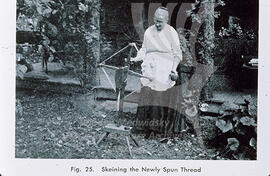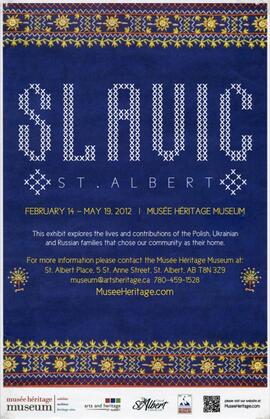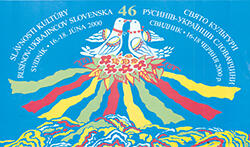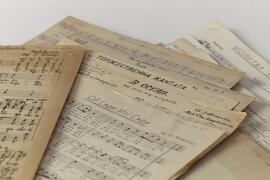Exhibition explores the lives and contributions of the Polish, Ukrainian and Russian families in the community, St. Albert Musee Heritage Museum
This collection consists of five final papers by students in the SLAV-204 class Slavic Folklore & Mythology taught by Maria Mayerchyk, Huculak Research Fellow, in the Fall term 2019. Topics covered are Dovbush, Ukrainian wedding, Baba-Yaga, Propp, and symbolism of the rooster. This collection also contains a copy of the course outline.
Poster advertising for a cultural event on June 16-18, 2000. Ukrainian text reads "Sviato Kul'tury Rusyniv-Ukraintsiv Slovachchyny Svydnyk".
The collection consists of field materials collected by Slawa Basarab as part of her assignments for the folklore courses she took at the University of Alberta, and include collected proverbs and beliefs about folk medicine, and folk sayings relating to health.
Basarab, SlawaFile consists of slides with Dobrolige’s works
The Sluzar Music Score is a collection of over 1,600 handwritten, copied and printed sheet music items and musical scores, and it contains more than 2,500 individual songs. It contains a unique variety of musical genres – from folk songs to opera and operetta scores, and from classical to liturgical and spiritual songs. Most of the pieces are arranged for choral performance; however, many solos, duets, quartets, and even instrumental arrangements are included as well.
The collection spans nearly a century in its compositions and publications, from the late 1800s to the end of the 20th century. Its songs reflect the incredibly rich historical legacy of the Ukrainian people and chronicle events from Cossack and chumak times all the way to the World Wars of the 1900s. The collection also strongly reflects the customs and traditions of the Ukrainian people through its assortment of folk songs – from hahilky and Kupalo songs to koliadky and shchedrivky.
Sluzar, WolodymyrKlid speaks about small businesses.
Klid discusses smart cards (cards containing chips such as, credit cards).
The interviews are with the author's father about birth, wedding and funeral customs in the Ukraine. The paper, however, describes only the death and funeral customs in more detail with references to literature
Hirniak, IrenePart 1: Nee - Khraplyva; born on December 24, 1912 in Ladywood (Manitoba); her parents came to Canada in 1898, stayed for 2 years, and then returned to Halychyna because her father’s mother had died; they the whole family came back to Canada in 1901; family was Orthodox in the old country but she was baptized in Ukrainian Catholic church in Canada; during WWII went overseas (November 1943), Ukrainian Canadian Services Association, Panchuk; she became the first Treasurer; the building was rented (it was an Anglican Church); living in barracks; Helen Kozicky; she came to Canada in March 1946, stationed in Ottawa and came to Winnipeg to be discharged in September 1946, and then went back overseas with a group in October 1946; Ukrainian Canadian Relief Mission = Ukrainian Canadian Mission for Ukrainian Victims of War; Froliak; Urbanovych (??); Captain Davydovych (??); UCSA closed in December 31, 1945 and CURB (??) started on January 1, 1946; Gordon (??); Korostovych (??); Skoropadskyi; CUC; Horoshko; Mrs. Mandryka; Froliak playing politics (Banderivtsi); George Kliuchevskyi (??); Mrs. Kowalsky (??); being in British zone of occupation.
Part 2: Being in American zone of occupation; Kushnir; Panchuk left in December 1947; DPs, DP representative, Relief Fund; coming back to Canada in 1947, giving lectures with Panchuk; League of Nations; Gordon; DPs; German transit camp; SUP (??)
Part 3: Panchuk and Yeremovych (??); Liquidation Commission; Korostovych (??); the Vasylyshyns; Andriyevskyi (??); secret instruction from Canada regarding Ukrainians; Gordon; SUP annual meeting; CPUE; Smith was a Director of the Canadian Ukrainian relief fund, Vasylyshyn succeeded her; Dorothy Yanda (??); she came back in 1952 and Relief Fund was finished; her husband was George Colder (??); became a Supervisor of Canadian pensions.
Part 1: Born on April 1, 1915 near Dauphin, Manitoba; his wife is Odarka Buhais’ka (??) born in Cobalt, Ontario; they have 4 children; Peter went to a Public school on farms, went to University of Manitoba, then took dentistry in Edmonton, graduated in 1940; now are Orthodox but came from Halychyna as Ukrainian Catholics; Peter went to a summer Ukrainian school in Keld (Haliovs’kyi - teacher, Barkovych, a student of Avramenko); growing in the Ukrainian area of Kosiv near Dauphin; buying a farm for $1200; Prosvita Hall; Arsenych the teacher at a school in the Kosiv school; Orthodox vs Catholics; Ukrains’kyi holos; Bishop Budka’s letter in 1914; Vasyl Svystun, Myroslav Stechyshyn, Kubryk; Orthodox church in Canada was more political than religious; French and Belgium becoming priests for Ukrainian churches; Ukrainian Communists; Danylo Skoropadskyi’s visit to Dauphin; Smilsky stayed at the Hrushevskyi Institute; Dmytro Mel’nyk, Danylo Kobyl’nyk, Faryna - his Institute friends; John Decore organized a Students Club (about 11 members), polkovnyk Sushko came once at the meeting; Samostiinyky; UNO; activities of the Student Club, pani Mykhailenko; Volodymyr Kupchenko.
Part 2: Meeting Doroshenko; spending summer on a farm; UNO; Pacification in Halychyna; newspapers on Holodomor; assassinations of Petliura and Konovalets’; pro-German sentiment before WWII; DPs; he sat a practice in Hamilton; Ivan Pylypiuk; Ukrainian Orthodox group in Hamilton, Zavadovskyi (??); Fedorkiv; Fodchuk; WWII, Anthony Hlynka, Ukrains’kyi holos; Karpats’ka Ukraina; Fr. Voloshyn; he went overseas, to Amsterdam; Dr. Kapusta, Dr. Ruthyk (??); Panchuk; Ann Khraplyva; Helen Koziy (??); Fr. Horoshko.
Part 3: Panchuk and a choir; UCSA; Fr. Horoshko; Helen Koziy (??); CUC; Tracy Phillips; Ukrainian Information Bureau; Steven Davydovych; Dr. K; discrimination against Ukrainians during WWII; 1944 - the Jump (??), Panchuk; Ukrainians at the Polish Forces; DP camps; Bishop Buchko; Mykola Lebid’; Danylo Skoropads’kyi.
Part 4: A split inside the Nationalists camp; Mykola Lebid’; Mel’nyk; Danylo Skoropadskyi’s visit to UCSA; Lady Hill; Bishop Buchko; Panchuk, Tracy Phillips taking action against shipping DPs back to the USSR; MP Michael Foot (??); UN first assembly in 1945, attended it with a press pass; Mykola Bazhan representing USSR; Hector McNeal (??); speeches about DPs; Panchuk; Steve Davydovych, Froliak; Mrs. Roosevelt’s speech; Central Ukrainian Relief Bureau’s name.
Part 5: UNO split; Prosvita; Canadian Legion Branch; Bozhok from UNO; Steven Pawluk (??); CUC in Hamilton; Povoroznyk (??); he came back to Canada in 1947 and went to school in Toronto, change in Ukrainian community in Canada; Orthodox and Catholics; DPs in Canada; Ukrainian Canadian Veteran Association; John Karasevych (??); Dr. K. suggested the name of “Olive Branch”; a branch of veterans in Hamilton, membership; Yaremovych (??)
Part 6: Karasevych; Yaremovych (??); John Yuzyk; Kosar came to Hamilton of behalf of CUC shortly after WWII; Bishop Borets’kyi (??); Ukrainian Communists in Hamilton; SUS, its branches and Congresses; changing the name of the Hrushevskyi Institute; oral surgery in Canada; Dr. Diamond; Ivan Homeniuk, Peter Homeniuk, Ryshchak (??); Klymashko (??); Panchuk; Smilsky became a Chairman of the board of directors of the Institute in Toronto in 1963; Oryshchak (??); Steve Davydovych; Kyrylyk (??) - cultural director; General Hryhorenko; Hrabovskyi (??); Hryhoriak (??)
Part 7: Students Club at the UofToronto (Burshtyns’kyi and Smilsky supported it); perogy eating contest reminding about the spaghetti eating contest; teachers of Ukrainian and Hamilton area; Stechyshyn (??); Smilsky losing money for the University Program to exist in 1963; Metropolitan Illarion’s visit.



